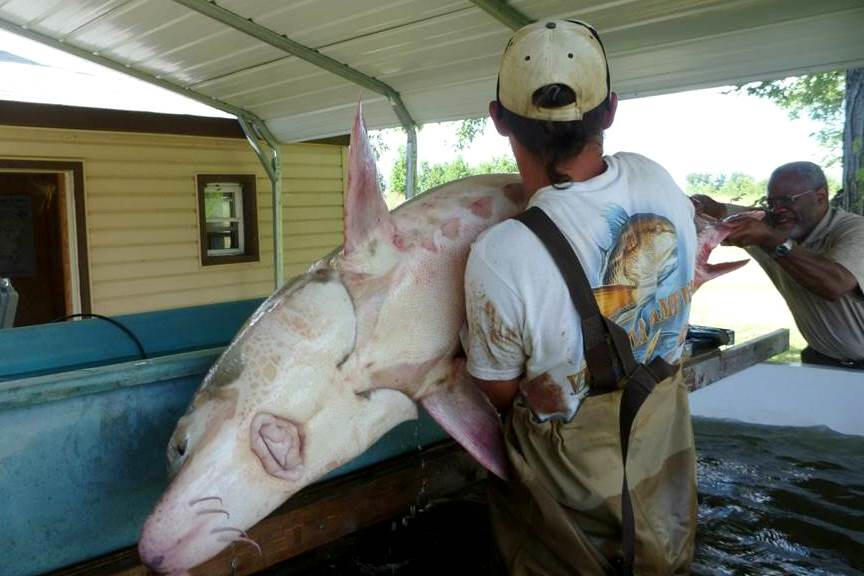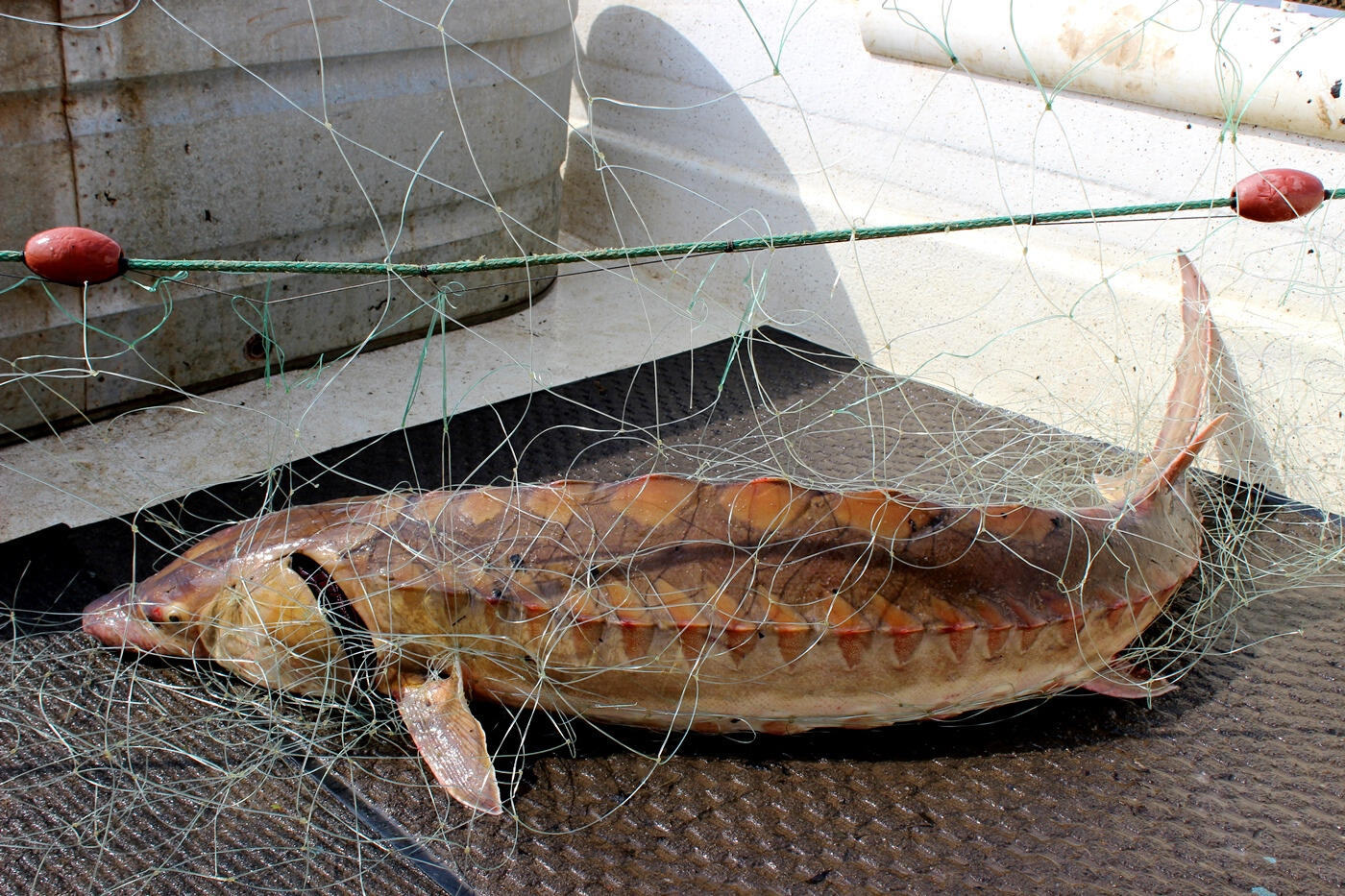Aug. 20, 2014
Sturgeon rising
VCU researchers continue population recovery efforts of iconic, prehistoric fish in James River
Share this story
Last fall, while out on the James River, biologists Matt Balazik and Martin Balazik made quite the catch. It was an 8-foot-long, 240-pound, female Atlantic sturgeon — so massive, it broke the stretcher used to transport it between the river and nearby observation tank.
A closer examination showed her belly was ripe with mature eggs — a sign that spawning season was around the corner.
The discovery of this pre-spawn female sturgeon was a first for Matt Balazik, a researcher with the Virginia Commonwealth University Center for Environmental Studies and VCU Rice Rivers Center. Balazik was not alone – Albert Spells, a Virginia Fisheries coordinator at the U.S. Fish and Wildlife Service, and Mike Odom and Cyrus Brame, also with the U.S. Fish and Wildlife Service, were on hand to assist with handling the fish.
After being fitted with a tracking tag, she was released back to the river. Balazik and Spells monitored her movement as she made her way to the spawning ground in the James River.
Then, just weeks after this encounter, the team caught 23 male sturgeons in a span of 50 minutes. Each were fitted with a passive integrated transporter tag, similar to chipping a pet dog, and were evaluated for good health.
Once the fish were back in the water, the pair of biologists made another discovery.
“This was the fall spawning run,” said Balazik, who has been studying sturgeon for the past several years to understand the sturgeon biology and life history in an effort to aid in their population recovery.
“Historically, this is an event that has remained hidden from us,” he said.
According to Balazik, the activities observed last fall add to a growing body of scientific evidence demonstrating Atlantic sturgeon have two distinct spawning runs completely separate from each other in the James River — one in the spring and one in the fall.
“During the spring run, between April and May, a bulk of sturgeon come into the river. We’ve observed that many of the fall spawn fish come up in May, and stage in the lower part of the river downstream,” Balazik said.
“So, the fall spawn fish stage early in the year. We thought the fall spawn fish were the spring spawn fish, which is how the fall spawning event has remained hidden to us. But now we’ve figured that out,” he said.
Today, all along the coast, sturgeon researchers in North Carolina, South Carolina and Georgia are describing fall spawning. Balazik is currently working on a research paper that focuses on the dual spawning events being observed along the East Coast.
“This evidence could have significant implications for future management and recovery of the fish,” Balazik said.
Although, there was previous work done in the late 1990s in South Carolina that hinted toward fall spawning, Balazik’s team has been among the first to connect with federal managers, such as National Oceanic and Atmospheric Administration, and encourage them to take a closer look at their sturgeon populations.
Population growth

In addition to the evidence of dual annual spawning events, Balazik and his colleagues report a surge in the sturgeon population and increased awareness of the prehistoric fish.
When Balazik began studying the iconic fish in 2007, he only caught two fish in that first year. Two years later that total increased to 14 and the next it hit 34. In 2011 and 2012, he and his colleagues caught 75 sturgeons.
“The population is skyrocketing. We’ve become much better at fishing and knowing when to target, and how to target them,” Balazik said.
“At one time, catching 30 was a big deal. But this year, our catch numbers went through the roof – last year, we caught 162. So now we’ve really figured them out,” he said.
Fish behavior
Sturgeon are unintentionally struck and killed by ships and other vessels that pose a threat to their population growth. Researchers are interested in reducing the incidence of sturgeon being hit by boats, and are delving into how they react to large shipping vessels and other boats.
“Shipping is getting bigger and it’s a less expensive way of moving goods. A lot of places want to deepen or widen their channels — so we need to figure out how the fish react to these big boats,” said Balazik.
To do this, researchers are using a grid of receivers that are set up in a distinctive pattern in channels in Virginia and Delaware — areas that report frequent ship strikes. The work is being conducted by VCU Rice Rivers Center researchers and a group in Delaware. A camera is installed in the vicinity of the Rice Rivers Center that will allow the team to visually monitor if there is a small pleasure craft or a large ocean liner in the channel.
“If a fish is in there, we can see what they do – do they stay or do they get out of the channel?” Balazik said. “It will be interesting to see how the sturgeon react to the large vessels, which are the ones that are likely hitting them.”
“Depending on what the team observes, the findings could have significant implications for management. It could lead to restrictions during certain times of the year in these narrow waterways,” he said.
The team is in the early stages of analyzing the data now.
In other work, Balazik has been investigating the use of an anesthesia system, called electronarcosis, to reduce handling stress in fish when they are being examined. The system is an alternative to the chemical process currently used that could cause damage to the fish.
“The system we are investigating has improved safety and efficacy,” Balazik said. “Fisheries management is now encouraging most investigators to use this method because it does not introduce toxins to the fish or the environment.”
While there is a lot of work ahead, Balazik remains encouraged and dedicated to seeing a change for the sturgeon population overall.
For Balazik, each new sturgeon he encounters is an opportunity for learning, for making observations, and a chance to turn the tide for the recovery of this prehistoric wonder.

Subscribe for free to the weekly VCU News email newsletter at http://newsletter.news.vcu.
Subscribe to VCU News
Subscribe to VCU News at newsletter.vcu.edu and receive a selection of stories, videos, photos, news clips and event listings in your inbox.













